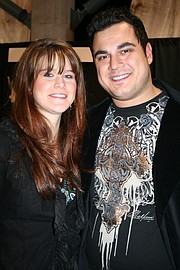From surveyor to attorney to politician to judge, Robert William Wells left his mark in history in more than one way.
For Jefferson City, he built a historic home in the style of a steamboat at the corner of Adams and East High streets, where the Missouri River Regional Library stands today.
For the state, he was the designer of the Missouri State Seal.
This fascinating character in the Capital City's history was rediscovered when local historian Henry Gensky was researching the state seal for a Missouri State Museum presentation.
A museum interpreter, Gensky often talks with visitors about the seal on the floor of the Capitol Rotunda. But he was curious about its creator.
Many holes remain in Gensky's research about Wells.
But a few were filled in recently when a former National Archives regional director discussed her research on Well's son-in-law - Frank White, a noted Union officer during the Civil War - with the Cole County Historical Society.
Kelle Green Blake and Gensky exchanged information and also shared the quandary of what happened to some family members.
Gensky's interest was piqued after reading a 1935 Missouri Historical Review article, published after the Missouri State Historic Society discovered a letter written in 1847 by Wells, explaining his work on the seal design.
The letter was found not long before Wells' unique home called Maple Terrace was razed.
The Cole County Historical Society in 1942 placed a marker at the corner of Adams and East High streets, recognizing where the historic home once stood. Now the brass seal is rusting, and Gensky hopes to see it restored.
Gensky also recently donated a framed a photo of the riverboat Gothic-style home with a portrait of Wells to the Missouri River Regional Library, on the home's original site.
The stone retaining walls around the home were still in place in 1947, when Gensky recalls sitting upon it and watching the parade with President Harry Truman and British Prime Minister Winston Churchill.
Wells was a legislator, attorney general, U.S. district judge, president of the Constitutional Convention of 1845, law reformer, curator of the University of Missouri, charter member of the Missouri Historical and Philosophical Society and of the Missouri Fruit Growers' Association, Union advocate, leader in emancipation movements and an advocate of Osage River navigation.
He was born in Virginia, and at age 21, he served as a federal deputy surveyor in north central Missouri. And after studying law back east, he returned to Missouri to practice in St. Charles by 1820.
In 1821, he served as deputy attorney general under Edward Bates, the state's first attorney general. That December, Wells took it upon himself to design an official seal, since the first General Assembly adjourned without adopting one.
His drawing based on heraldic principles was adopted Jan. 11, 1822. And he took one of the St. Charles County representative seats in November 1822.
Wells moved to Jefferson City in 1826, after being appointed the state's third attorney general. He held that post when Mormons being persecuted in northwest Missouri sought to form a militia and he investigated when charges were brought against them.
President Zachary Taylor appointed him U.S. district judge in 1836. In that capacity, he expedited the Dred Scott case in 1854 from Missouri to the U.S. Supreme Court.
Wells maintained his office in the Capitol. Not only did the 1837 fire claim most of Well's valuable papers and books, it also consumed the original state seal.
Wells, who represented the counties of Cole, Miller and Morgan, served as president of the 1845 state convention to formulate a new constitution, and afterward, he wrote an explanation for public distribution.
Then, in 1860, he was among a group of pro-Union men who privately planned to resist the elected, pro-confederate Gov. Claiborne Jackson.
Wells was elected president of the first and second emancipation conventions in 1862 and 1863. However, at his death in 1864, he owned eight slaves.
Locally, Wells served as chairman of a citizens committee interested in increasing Pacific railroad subscriptions and constructing plank roads in 1851.
He and his family were among the passengers who survived the inaugural train ride, which ended with the collapse of the Gasconade River bridge.
When not engaged in public affairs, Wells enjoyed managing 1,300 acres of fruit trees east of the city.
From his days as a surveyor, Wells knew the value of some of the choicest lots, which he purchased following the survey done by Daniel Boone Jr. in 1825. Some of those prominent locations include the Grace Episcopal Church corner and several along West High Street, where the Capitol lawn is today.
However, Maple Terrace was built on a lot he purchased later. Constructed in the steamboat Gothic-style, the two-story home featured heavy gingerbread wooden trim and an exterior spiral staircase.
Before the Civil War, Maple Terrace was one of Jefferson City's social centers, according to a 1935 Sunday News and Tribune article. The home later was used as a school and divided for apartments, before it was razed in 1936.
Two of Wells' daughters were also involved with local Civil War-era love stories.
Mary, daughter from his first marriage to Harriet Rector, eloped with M.M.Parsons in 1850. Later, the pro-union judge's son-in-law would become a Confederate officer. But Mary already had died by 1853.
Cornelia, daughter from his second marriage to Eliza Covington, caught the affections of Union Capt. Frank White, known for his military accomplishments at Jenkins Bridge. White and Cornelia met at a local party, while he served as provost marshal and judge advocate general in Jefferson City early in the war.
Wells is buried in Woodland Cemetery with his first wife, a daughter and several grandchildren.
Author Roy King concluded, "Wells nobly typified the pioneer Missourian. Of humble origin, educated through his own industry, he settled in a frontier state and rose to positions of honor and trust.
"His leadership was recognized and valued in many public and professional enterprises."

